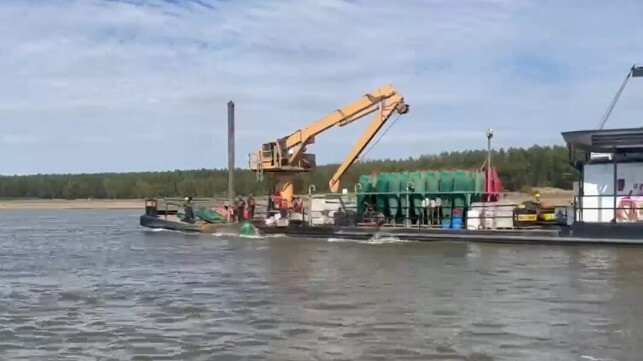Mississippi's Falling Water Level Continues to Impact Inland Commerce

The Mississippi River's water level continues its downward trajectory, with substantial implications for agriculture and commerce in the American heartland. The depth is approaching a historic low last seen in 1988, and it is slowing barge traffic to a crawl.
The river gauge now sits at -8.9 feet at Memphis, three feet lower than it was last weekend, and there is little if any relief in the forecast. The water level at Memphis could approach -10 feet by the end of the month, according to a National Weather Service Forecast, and the extended forecast predicts below-normal precipitation throughout the Mississippi Basin for at least the next 30 days.
“There is no rain in sight, that is the bottom line,” Corps of Engineers spokesperson Lisa Parker told the Wall Street Journal. “The rivers are just bottoming out.”
The shallow water has forced loading restrictions on the barges that carry soybeans, oil, coal and other commodities up and down the river, limiting capacity and sending per-ton freight rates to incredible highs. The downbound tariff from St. Louis is about five times higher than it was last October. Daily groundings on the Mississippi's shifting sandbanks are impacting the flow of traffic, making arrival times unpredictable for traders (and in some recent instances, temporarily shutting or restricting navigation in affected areas). Narrowing channels have limited traffic to one way at a time in some areas.
"The preacher man said it’s the end of time and the MISSISSIPPI RIVER is going DRY......"
— Not El Chapo (@ScottEnlow) October 14, 2022
This is the Mississippi River between Vicksburg and Natchez. River barge traffic is at a standstill and it's soybean harvest season. This is terrible.
Photo Credit Mississippi Gregslist pic.twitter.com/p7qB1kPEmM
Check out how low the Mississippi River is in Tiptonville, Tennessee.
— ???????????????????????????? ???????????????????????? (@Dentonwx) October 10, 2022
(????: Burton Staggs) #tnwx #msriver pic.twitter.com/WTNmwEtMbI
Beans and other goods are PILING UP at farms along the Mississippi River. Dangerously low water levels in the river have caused barges to lighten up, so that they can navigate on the MIGHTY MISS. Take a look:pic.twitter.com/U7liJF73N9
— Steve Hanke (@steve_hanke) October 14, 2022

that matters most
Get the latest maritime news delivered to your inbox daily.
This has a direct effect on soy farmers, who are now harvesting their fall crop. Barge transport capacity is in short supply, and rail and truck transport are too limited to absorb the extra volume, so siloes are filling up in farming communities along the Lower Mississippi. In many areas, farmers have had to try to delay harvest or resort to storing their crops themselves, sometimes by piling them on the ground and tarping over with plastic.
“The majority of our product goes down the Mississippi River for export,” Tennessee farmer John Dodson told Investigate Midwest. “And if the terminal cannot take it, if the barges cannot move the grain down to the ports in New Orleans, we’re at a standstill, so those crops just sit in the field.”
